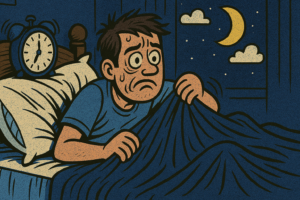Ever spent a night wrestling with your sheets instead of sleeping peacefully?
To move restlessly in bed due to an inability to sleep, often caused by anxiety, excitement, discomfort, or worry.
This common English idiom vividly depicts the frustration of restless nights. When you “toss and turn,” you’re constantly changing positions, flipping from side to side, yet sleep remains elusive.

Learn why this phrase resonates universally and how to use it confidently in your conversations.
Key Takeaways
- “Toss and turn” refers to a night of restless sleep, typically caused by stress, excitement, discomfort, or worry.
- Mastering common idioms can significantly improve your fluency and conversational confidence.
- “Toss and turn” appears in literature and daily dialogue alike, reflecting a universal human experience of sleeplessness.
- Understanding opposite expressions like “sleep like a log” can broaden your range of descriptive language around sleep and rest.
- Practical usage tips, personal stories, and memory aids will help you remember and apply this idiom correctly.
Understanding the Idiom
The idiom “toss and turn” describes the act of lying awake at night and repeatedly moving about, unable to sleep.
Often, this scenario is linked to anxiety, excitement, physical pain, or any kind of mental turmoil that keeps a person from relaxing.
It paints a picture of someone in bed, flipping from side to side, adjusting pillows, and generally feeling restless.
- For example, you might say, “I was so worried about tomorrow’s deadline that I tossed and turned all night,” or “He tossed and turned because his back was aching.”
- Unlike casual phrases such as “I slept badly,” “toss and turn” captures both the mental and physical struggle of trying to find rest.
A Humorous Misunderstanding
When you first come across certain English idioms, it is easy to picture their literal meaning. The phrase “toss and turn” might suggest throwing objects around a room or practicing some kind of acrobatic routine.
A friend of mine once confessed to misunderstanding this idiom in exactly that way. He thought it meant you were throwing things in frustration.



Eventually, he realized it was about feeling restless in bed, not flinging pillows at the wall!
Such misunderstandings are common with idiomatic expressions, which is why learning them properly is so important. Once you know the story behind an idiom, you are far less likely to mix it up in conversation.
Real Story: Samantha’s Challenge
Consider Samantha, who had a critical job presentation early one morning. She tried to go to bed early, hoping for a full night’s rest. Unfortunately, the anxiety of imagining every possible question refused to let her mind relax.
She tossed and turned for hours, repeatedly checking her clock, until she finally managed a few hours of fitful sleep.
The next day, she felt groggy and unfocused. When she said, “I tossed and turned all night,” her colleagues understood immediately that she had endured a miserable evening.
Afterward, Samantha realized her pre-presentation nerves had triggered her restlessness. By embracing stress-management techniques—like jotting down her fears on a notepad—she eventually reduced those sleepless nights.
This story highlights how “toss and turn” encapsulates both physical movement and emotional tension. It gives listeners a quick sense of why you are tired or out of sorts: you simply couldn’t switch off your racing thoughts.
Historical Background
The phrase “toss and turn” has been part of the English language for centuries. Its roots stretch back to early writings, where “toss” and “turn” both referred to physical actions that indicate unease or restlessness.
Over time, the words began appearing together to illustrate the motion of someone shifting around in bed.



Today, it remains widely used because it perfectly captures a universal human experience.
Regardless of cultural background, we all know what it feels like to be awake in the middle of the night, hopelessly rearranging pillows or flipping onto a cooler side of the mattress.
This timeless quality explains why “toss and turn” continues to thrive in modern conversation.
Practical Examples
To further illustrate when and how to use “toss and turn,” below are a few common scenarios. Notice how each example demonstrates both emotional and physical restlessness.
- Big Interview Worries
- “I was so nervous about my interview that I tossed and turned all night.”
- Explanation: Anxiety caused difficulty sleeping, leading to a restless night.
- Physical Discomfort
- “He tossed and turned because his shoulder was bothering him.”
- Explanation: Pain prevented a comfortable sleeping position, so he kept shifting around.
- Excitement Before a Vacation
- “She couldn’t wait for her trip, so she tossed and turned with excitement.”
- Explanation: Positive emotions can also cause restlessness, proving it is not always linked to negative stress.
Conflicts & Sleepless Nights
Sometimes, a disagreement or a heated argument leaves a person frazzled enough that sleep becomes elusive.
If you ever found yourself replaying a tense conversation, you understand how easy it is to get stuck in a cycle of overthinking. You might say, “I couldn’t stop thinking about our argument, so I just tossed and turned for hours.”
Joyful Hope Turns to Restlessness
On the flip side, not all sleepless nights stem from worry. Excitement over a new hobby or a long-awaited event can keep you awake as well.
This underscores how “toss and turn” captures that sense of stirring in bed, whether the cause is delight or dread.
Similar & Opposite
English is rich with colorful ways to discuss sleep quality. To enrich your vocabulary, here are a few related idioms:
Similar Expressions
- “Twist and turn”: Emphasizes a similar restlessness, though sometimes used more figuratively.
- “Roll around”: A colloquial way of saying someone moved a lot while trying to sleep.
Opposite Expressions
- “Sleep like a baby”: Describes deep, uninterrupted sleep, often without any worry.
- “Sleep like a log”: Conveys a heavy, undisturbed sleep. This is the direct opposite of “toss and turn” because it implies complete stillness.
Learning both sets of expressions helps you describe a range of sleep experiences. Instead of repeatedly saying “I slept badly” or “I slept well,” you can choose a more precise idiom.
Memory Aids
Sometimes, idioms slip our minds unless we associate them with a clear image or scenario.
One easy way to remember “toss and turn” is to visualize yourself in bed, physically rolling from side to side, tossing blankets aside, and turning onto a new position, all while failing to drift off.



That picture, complete with a sense of frustration, can serve as a strong mental anchor.
Another approach is to compare it directly with its opposite.
If you are consistently learning pairs of idioms—like “toss and turn” versus “sleep like a log”—you create mental contrasts that can help you retrieve these phrases faster when speaking.
Pop Quiz: Check Your Idiom Skills
Toss and Turn

Final Thoughts
Idioms add color to communication. Saying you “tossed and turned” expresses more than “I couldn’t sleep”—it paints a picture of restlessness that helps others relate.
This vivid language builds rapport and brings your experiences to life.



Notice how native speakers use “toss and turn” in conversations, books, or news.
With practice, you’ll use it naturally. The more idioms you learn, the more engaging your English becomes.









Comment